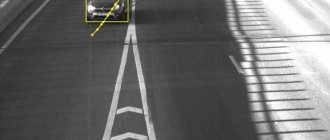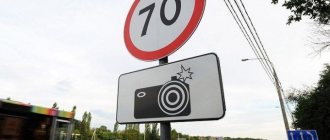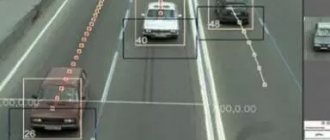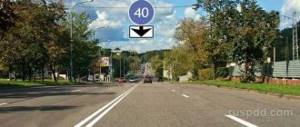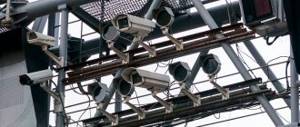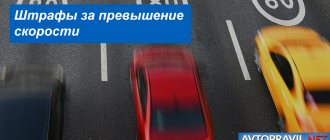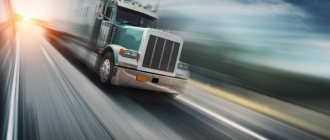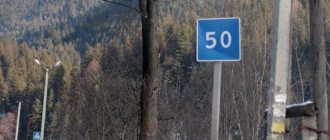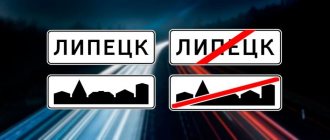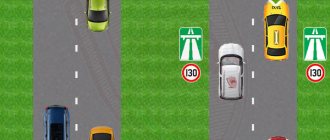Speed in free driving conditions
In free conditions, when the road is relatively empty and you can choose the speed at your own discretion, it would seem that everything is simple. If you follow the traffic rules, then this is 60 km/h in the city, 80 km/h on some city highways, 100 km/h on the Moscow Ring Road, 90 km/h outside the city and 110 km/h on the highway. Well, for those who like to play cat and mouse with the law, you can add those same “duty-free” 20 km/h to these values - there are no fines below this excess. But I’m not talking about fines now, but about safety. Let's imagine that there are no speed limits, like, say, on the autobahns in Germany. This means you can drive at any speed with impunity. At what speed is it safe to drive?
Safety = availability of reserve
Let us remember that one of the conditions for performing a maneuver is the presence of a thrust reserve. And that engine thrust - torque - depends on the tachometer readings (see the article “Driving safety and engine torque”). But the engine’s ability to accelerate a car also depends on speed: the closer the car’s speed is to maximum, the more difficult it is to accelerate . The car accelerates well at low speeds, and as it approaches top speed, acceleration becomes progressively slower. By the way, a few years ago, in the technical specifications of BMW cars on the manufacturer’s website, two acceleration times were given: for acceleration from 0 to 100 km/h and from 80 to 120 km/h. These indicators were approximately equal to each other. That is, when accelerating from a standstill, a car needs the same amount of time to accelerate from 100 km/h as when accelerating at high speed to accelerate from just 40 km/h. Do you feel what I'm getting at?
Even if it were possible to drive at maximum speed every day, you still shouldn’t do this, because any device, including the engine, operating at maximum, has no reserve.
Cruising speed
To preserve the engine's thrust reserve, it is necessary to limit the speed of movement and not approach the maximum speed value . How close can you get? Where is the border? The optimal speed is 60-70% of the maximum and is called cruising speed. The cruising speed of a car is that reasonable limit that should not be exceeded, even on open highways. That is, cruising speed is the maximum safe speed of a CAR .
Cruise speed is also the most advantageous travel speed in terms of travel time versus fuel consumption, so aircraft fly at cruising speed.
Let me get down to specifics. For example, for the VAZ-2110 the maximum speed according to the passport is 180 km/h, and the cruising speed is 108 km/h (60%). And if you take a VW Touareg with a power of 240 hp, then its “maximum speed” according to the passport is 218 km/h. And for him the cruising speed will be 130 km/h. Not much more than the Lada, right?
Thus, in order to always have a reserve of engine thrust in case of emergency actions and to be safe, do not exceed the cruising speed of your car, even in free-flowing conditions . And since the maximum permitted speed in Russia is 130 km/h, there is no problem of exceeding cruising speed. So follow the rules and everything will be fine!
And since the maximum permitted speed in Russia is 130 km/h, there is no problem of exceeding cruising speed. So follow the rules and everything will be fine!
The optimal speed for the car is the second factor in choosing a travel mode
The main criterion for choosing a speed limit is not the capabilities of the car, but your considerations about the safety and confidence of the trip. If you think that driving at a speed of 90 km/h under these conditions is dangerous, then it is better to choose a more comfortable and confident mode. However, there are certain recommendations from manufacturers.
The first thing worth remembering in this context of conversation is the average consumption. If you maintain the speed of the car at 90 kilometers per hour, then the consumption will be as close as possible to the passport consumption indicators on the highway. Many drivers worry that their car on the highway consumes more fuel than indicated in the documents. This happens for the following reasons:
- when overtaking, the car is forced to consume many times more fuel due to the need for rapid acceleration;
- Constant braking and starting in a traffic jam or on various obstacles also adds to the consumption;
- driving at speeds over 100 kilometers per hour begins to significantly increase gasoline consumption;
- the manufacturer calculates route travel modes at an average speed of 90 kilometers per hour;
- All functions and components of the car, gear ratios and engine are adjusted to this indicator.
It is for these reasons that average consumption figures are often an order of magnitude greater than the passport measurements. When determining fuel consumption in highway mode for the technical characteristics of a car, the manufacturer performs vehicle testing on a track where the car drives at a constant one recommended speed. This is what allows us to achieve such interesting fuel consumption figures.
To get maximum benefits in fuel consumption and other performance of your vehicle, experiment and try different driving modes. It would also be a good idea to read reviews about how people use your type of transport. This will help simplify the operation of the car as much as possible, reduce fuel consumption and predict any characteristics of the vehicle’s behavior. Remember that the speed must be justified. We offer a selection of videos of accidents that occurred in particular due to high speed:
Speed in traffic flow
We have all heard many times that the safest speed is the flow rate. It is true, and it is logical. After all, every advance or overtaking increases the likelihood of an accident, namely, a collision with the vehicle being advanced or the leading vehicle. It is clear from this that the less overtaking and/or advance, the less the likelihood of an accident. And movement without advances is possible in two cases: either on a free road, or in a stream of cars when moving at a speed of flow .
But how does the recommendation to move at the speed of the flow compare with the recommendation to choose speed based on visibility distance? Very simple. If by flow we mean cars in one lane moving along a narrow road between parked cars , we already discussed this in the previous article. When entering such an area, you should reduce your speed at your discretion and slow down all traffic behind you . If we talk about multi-lane traffic on highways, the issue of visibility is relevant only in the right or second rows - those closest to the sidewalks and parked cars. But in the center of traffic, on the same Moscow Ring Road and Third Transport Ring Road , this is not relevant, visibility is good everywhere, there are no parked cars, and there are no pedestrians either. it makes sense to stick to the flow rate there .
Advance speed
However, with proper skill and a relatively clear road, you can safely move faster (as well as slower) than the flow. But there are some subtleties here. As I wrote above, when you advance, the risk of a collision with the vehicle being advanced increases. After all, when approaching him, we first enter his blind spot, when the driver of this car cannot see us, which is already dangerous - the driver can start changing lanes in our direction without seeing us... Then we align with him, and here there is also a risk of collision - either the driver may change lanes, or will swerve to the side, avoiding a hole, or a tire will burst, or the car will skid, in general, there are many reasons for concern. Further, we move forward a little, and the car ahead gets into our blind spot, and we can no longer see it, which is also undesirable. And after all this, we drive forward to a safe distance at which we can clearly see this car.
As you understand, the faster we pass the car ahead, the better, but “without fanaticism.” The recommended difference in speeds is at least 10 km/h and no more than 20. That is, 10-15 is optimal, 20 is the limit, and then it’s recklessness . Because with a greater difference in speeds, the time to assess the situation is reduced, the braking distance increases, and therefore the ability to adequately react to the actions of cars in front is reduced.
It is possible to measure the difference in speeds with the car in front, but it is difficult, and during a maneuver there is no time for this at all. It's much easier to express this in seconds.
The optimal time to advance in the adjacent lane without changing lanes is 6 seconds . What do I mean by lead time? The beginning of advance can be considered the moment when you approached the car in front at a distance of the length of a passenger car. Why exactly at such a distance? Because in this case, another car will no longer be able to squeeze between you. And approaching the one ahead in the next row at a distance of one car, you enter the danger zone. You exit it when you are ahead and more than one car's length away from the car.
Thus, advance consists of three phases:
- entering the danger zone;
- advance;
- leaving the danger zone.
With the proper speed difference, each phase takes about 2 seconds, and the entire advance takes about 6 seconds. It can be done faster (again, without fanaticism!). Slower is not worth it.
So, it should take no more than 6 seconds to pass a car in the next row.
I will give calculations in case the number 6 is in doubt. Look, even if you are ahead with the minimum recommended speed difference - 10 km/h, in 1 second the car will travel about 2.8 m, and in 6 seconds - almost 17 m, that is, 4 car lengths. Just what you need.
It follows that it is not always permissible to continue moving at a constant speed. If you catch up with a car in the next lane and realize that the speed difference is small, speed up . After getting ahead, you can reduce the speed again to the previous one.
If the other driver is ahead of you quite slowly, create the necessary difference yourself by releasing the gas pedal . And after passing it, you can pick up the previous speed again.
Overtaking speed
Overtaking - getting ahead in the oncoming lane
Until November 2010, overtaking was considered any advance associated with leaving the occupied lane. But after changes to the traffic rules in November 2010, only moving ahead in the oncoming lane began to be considered overtaking . This means that overtaking is only possible on roads with one lane in each direction, since on roads with a large number of lanes entering oncoming traffic is always prohibited. And yet, two-lane country roads have a speed limit of 90 km/h for passenger cars without a trailer, which means this is your speed “ceiling” when overtaking + a “duty-free” reserve of 20 km/h.
Another interesting nuance: previously overtaking on the right was prohibited, which meant driving on the side of the road or on the right lanes of a multi-lane road. From the new definition of overtaking it follows that overtaking on the right is impossible in principle, since in Russia there are no oncoming lanes on the right . No one prohibits overtaking on a multi-lane road on the right, which means it is legal. No one talks about ahead on the roadsides and sidewalks, since traffic there is prohibited in principle.
Overtaking is one of the most dangerous maneuvers. Therefore, before overtaking, you need to weigh the pros and cons. Obviously, overtaking must be permitted by the Rules, and you can read about this in section 11 of the traffic rules. Of course, when overtaking, it is especially important to use the turn signals in order to be clear and predictable for other road users. And here I will talk about the most important point - the difference in the speeds of the overtaking and overtaken cars.
The faster you go, the safer it is to overtake.
When overtaking, the time the overtaking vehicle spends in the oncoming lane should be minimal. The ideal time from the moment of entering the oncoming lane until returning back to your lane is 3 seconds, maximum 5 seconds . Is it possible? Certainly! Create a speed difference of 30 km/h and anything is possible.
Again, let's figure out what we get in numbers. Let's say we are overtaking a Gazelle about 6 m long, its speed is 70 km/h, ours is 90, the total difference is 20 km/h - the minimum allowable difference when overtaking in the oncoming lane. This speed is about 5.6 m/s, and in 3 seconds the car will travel 16.8 m - again, 4 car bodies - normal. And in 5 seconds we will travel as much as 28 meters. More than enough!
Let's take another, more severe example - overtaking a truck. They are usually about 14 meters long. Suppose the speed of the truck is the same 70 km/h, and a difference in speed of 20 km/h will no longer suit us, we take 30 km/h, that is, 8.3 m/s. We need to go into the oncoming traffic at a distance of at least 2 car bodies from the truck, that is, about 10 m. And somewhere at the same distance we need to leave the oncoming lane. In total, it will take 10+14+10 = 34 meters to overtake a truck. With a speed difference of 30 km/h, we will cover this distance in 4 seconds. Q.E.D.
Therefore, it is necessary to move in the oncoming lane with maximum acceleration, or at a constant speed, having created the above speed advantage in advance .
Safe overtaking technique
You should speed up:
– in low gear;
– in the speed range of engine speeds;
– with the gas pedal pressed to the floor.
On cars with an automatic transmission, use the kick-down mode - fully press the gas pedal.
Correct and safe overtaking is overtaking in which it takes no more than 5 seconds from entering the oncoming lane to returning to your lane. Maximum 5, ideally 3 seconds.
What if you can’t create such a difference? Or if a Gazelle goes 80 km/h, how can you create a speed difference of 30 km/h, since the speed limit is only 90 km/h? If this is the case, you can speed up locally, gain the desired speed difference, slightly exceeding the duty-free limit of 20 km/h, and then reduce the speed to the permitted speed. If the Gazelle moves even faster - at the maximum permitted speed - overtaking is simply not advisable. You don't need it, you don't need it.
Moving faster than the flow
And a few more words about the advisability of overtaking and advancing - that is, about moving faster than the flow. Sometimes drivers try to get ahead of the flow: “playing checkers”, “embroidering”. Some people do this because they are late, while others are simply bored “vomiting” in a stream of “onlookers” at 80 km/h along the Moscow Ring Road. By the way, I join the second category of drivers.
Faster than the flow - no slowdowns
So, there is a specific indicator of the correctly selected speed. As in the case of cornering, this indicator is the brake pedal. If you are trying to pass traffic and have to press the brake pedal to adjust your speed, then you have exceeded the optimal speed for that traffic. And the more often and more intensely you brake, the greater the excess. To adjust the speed, it should be enough to release the gas pedal, and if you manage to do this without braking, then you have chosen the right speed.
However, you may object: how can this be? Sometimes it happens that you can’t get around the traffic without braking! What should I do? And in this case, moving faster than the flow is simply impractical. Curb your ardor and accept the speed of the flow.
Thus, it is advisable to move in traffic at a speed at which you do not have to press the brake pedal (traffic lights, traffic jams and intersections do not count). Either you drive at the speed of the flow, or slightly exceed its speed - by 10-15, in extreme cases - 20 km/h. If you cannot move faster than the flow without braking, it means that it is impossible to go around the flow, and you need to move at the speed of the flow.
plug1
According to data published on the official website of the State Public Institution “Traffic Organization Center” (TsODD), in June the Garden Ring, the Moscow Ring Road and the capital’s outbound highways were traveling at the same average speed of 56–57 km/h. The same picture was observed in the previous months of the six months - the deviation was no more than 1–3 km/h in one direction or the other. Thus, the average speed along Sadovoy in February was 53 km/h, in March - 54 km/h, in January and April - 58 km/h, in May and June - 57 km/h.
The average speed on the Moscow Ring Road reached 56 km/h in January, 55 km/h in February, 57 km/h from March to June inclusive. Let us remind you that at the beginning of July, the capital’s Traffic Management Center announced that the Moscow Ring Road went faster by 7%. This was explained by the ban on the movement of heavy trucks during the day, which allowed not only to relieve congestion on the ring road, but also to save 0.5 billion rubles annually.
At the same time, outbound highways traveled more slowly: in March, the average speed of cars traveling along them did not exceed 53 km/h, in April and May - 54 km/h, in June - 56 km/h.
Speed on long trips
The recommendation to drive without braking is especially relevant for those who enjoy long-distance driving. From those who often travel from Moscow to St. Petersburg, to Crimea, I often hear stories about driving on highways at speeds of 150 km/h and that in some areas you often have to overtake trucks. “How long did it take you to get from Moscow to St. Petersburg?” - I ask. “In 10 hours,” the reckless driver answers. This is where the dog is buried...
The concept of uniformity of motion
Look, from Moscow to St. Petersburg is about 700 km. If the driver drove without long stops for 10 hours, then his average speed was 700/10 = 70 km/h. It turns out that in empty sections he drove 150 km/h in order to arrive at an average speed of 70??? Was the game worth the candle? It is already clear to the naked eye that it was not worth it and that the speed was clearly too much. I'm not even talking about violating traffic rules, I'm just fighting for common sense. And if you look at the situation not just with the naked eye, but evaluate it scientifically, then there is a so-called coefficient of uniformity of movement:
K = Vcp/Vmax
where Vcp is the average speed along the way, and Vmax is the maximum speed that the driver maintained on the way.
The closer the coefficient is to unity, the more uniform and expedient the movement. That is, the closer the average speed is to the maximum, the more uniform the movement and the more appropriate the selected speed .
In our example with Moscow and St. Petersburg, the uniformity coefficient is 70/150 = 0.47. A very mediocre result, to put it bluntly. In free driving conditions, outside the city, the recommended values of the uniformity coefficient are above 0.7. It is clear that there is no such thing as exactly 1, but 0.9-0.95 on an open road without traffic lights is easy. In the city we can already talk about 0.4-0.5, but not on the St. Petersburg highway.
Evenness of movement is more important than speed
That is, in our example, the driver did not have to drive 150 to get there at an average speed of 70. It was advisable to reduce the speed. Many people think that reducing the maximum speed will lead to the same reduction in the average. For example, if you drive not 150, but 30 km/h slower - 120, then the average will end up not 70, but 40. This is a fallacy! In our example, the average will not change in any way, that’s the secret! If you try to drive evenly, in practice the average speed is only slightly lower than the maximum. In our case, the average speed will be 70 km/h, I think, if we try to keep it at 80 km/h the whole road. Do you feel the difference? Drive 150 or calmly hold 80 and arrive in the same time! In practice this will be the case. The trick is that you can’t keep 150 all the way. While you are driving to St. Petersburg, you encounter populated areas, traffic police posts, trucks, dangerous sections of the road - and all this forces you to slow down. And in the case of trucks, it happens that you end up in a “caravan” and have to overtake several dozen of them in turn, and drag for a long time behind each of them. It is in these places that we lose everything we have won, squeezing out 150 in each free area. Therefore, you should not waste unnecessary effort and fuel; you need to drive at the speed that will lead to uniform movement. Believe me, the average speed will not be affected in any way, but you will save a lot of fuel, effort and nerves, and add comfort and safety.
Evenly - when there is no braking
How to determine this optimal “uniform” speed? After all, you have to sit there, calculate the average, divide by the maximum, these coefficients... You'll be tortured! No, in practice everything is much simpler and is no longer new. You need to drive at the highest possible speed without braking. Then the movement will become uniform, and the speed will be close to average. That is, if you find yourself in a caravan of 20 trucks that go 80 km/h and which can only be overtaken in the “oncoming lane”, where cars are constantly driving towards you, you should not overtake them. You need to humble yourself and follow the truck. Or, as an option, you can make a previously planned stop (to refuel, rest, eat) and let the caravan go ahead, so that you can then drive along a freer road. If you lose, you will lose quite a bit in time, but you will gain, I repeat, in fuel consumption, strength, comfort, and safety. And again we come to the expediency of moving at the speed of the flow, only through other considerations
That is, if you find yourself in a caravan of 20 trucks that go 80 km/h and which can only be overtaken in the “oncoming lane”, where cars are constantly driving towards you, you should not overtake them. You need to humble yourself and follow the truck. Or, as an option, you can make a previously planned stop (to refuel, rest, eat) and let the caravan go ahead, so that you can then drive along a freer road. If you lose, you will lose quite a bit in time, but you will gain, I repeat, in fuel consumption, strength, comfort, and safety. And again we come to the expediency of moving at the speed of the flow, only through other considerations
Fines for average speed: changes are being prepared for motorists
The Ministry of Justice will consider a proposal from the manufacturers of traffic cameras to include a new wording in the Code of Administrative Offenses - a fine for exceeding the average speed. Drivers already receive such orders, but consider them illegal.
The Ministry of Justice will consider proposals to include in the draft new Code of Administrative Offenses the concept of fines for exceeding the average speed. An analysis of this possibility will be carried out together with interested government authorities. The department reported this in response to a request from Autonews.ru about the fate of the corresponding appeal from the Association of Manufacturers and Operators of Recognition and Photo-Video Recording Systems “Oko”. Now there are no clarifications on average speed in the legislation, but drivers still continue to receive “chain letters”.
Earlier, Autonews.ru was the first to report that experts and device developers proposed in this way to resolve disputes between motorists and TsAFAPs and the courts.
Let's figure out how they plan to punish those who exceed the average speed.
What is average speed, how is it calculated and why is it needed?
The average speed of a car is the speed at which the driver drove a certain section of the road between two synchronized cameras located at the beginning and end of the control section. To calculate the average value, you need to divide the controlled distance by the travel time. If the resulting figure is higher than the current limit, the driver will receive a fine depending on how fast he was driving. The amount of fines does not differ from the punishment for “instant” fixation. For example, if you exceed 20–40 km/h, you will receive a fine of 500 rubles, and so on. At the same time, the controlled section should not have alternative travel routes, and the maximum speed limit should be the same along the entire route.
According to the Oko association, Tatarstan has become the leader in the use of average speed control systems in Russia.
There, more than 950 km of highways are controlled in this way. In the Moscow region there are 68 average speed control sections with a total length of 254 km. “In this regard, Russia is following the same path as all developed countries, where compliance with speed limits on an increasing number of roads is controlled in this way,” the association clarified, adding that the future lies with cameras with this function.
Pros and cons: why the fine for exceeding the average speed should be abolished
“When controlling the average speed, the so-called “kangaroo effect” disappears, when drivers suddenly brake in front of the camera and accelerate after passing it, thus increasing the risk of accidents,” the manufacturers said. “This, in turn, increases the road capacity due to more uniform movement of vehicles on the site.”
Oka experts also noted the cost-effectiveness of choosing such devices on the part of the authorities: to close accident hotspots with a length of more than 1 km, it will be necessary to install only two average speed cameras instead of several cameras recording the speed at a given point, since the range of the latter is usually 200–500 meters.
What's wrong with the fines issued?
Head Sergei Laskin (not a member of Oko) said that many regional authorities refuse to install such devices precisely because of constant dissatisfaction from drivers.
“We ourselves suggest that customers install cameras with average speed control on sections of 20–30 km; it’s simpler and cheaper. And such situations will not arise when the driver, having received a warning from the navigator, slows down, and then drives even harder than before in order to make up for the supposedly lost time, and then only slows down at the next camera,” Laskin shared.
According to an industry participant, customers are put off by the frequent cases in which courts overturn fines. This is also due to unresolved issues with establishing the exact location of the violation.
“Under current conditions, it is impossible to accurately write that a violation occurred, for example, at the 20th kilometer of the highway. Exactly how many kilometers the driver exceeded is also unclear. After all, he could accelerate to 200 km/h in one place, then drive slower, then faster again, and it turns out that the fine does not correspond to the real violation,” Laskin shares. — And all TsAFAPs belong to a certain community, which is very well informed about what is happening. And when one of the bosses writes that he installed these complexes, and then complaints pour in from the courts and the prosecutor’s office, others decide that they don’t need it. And judicial practice is not yet on the side of this topic. Therefore, competitions for such complexes are simply meager compared to others. And it is precisely this kind of fixation that is most effective in the fight against violators.”
Director Yuri Zarubin does not agree with Laskin’s position. He said that in the last three years alone, the company has launched several hundred speed control lines in the country.
“Now they are rapidly building new roads and long-distance routes, while measuring instantaneous speed does not meet the tasks of control on routes outside populated areas,” Zarubin clarified to Autonews.ru. — This is about 87% of all roads in Russia. These arguments are well understood in the regions. The combination of using “instant” and “average” speed control gives the optimal effect.”
The position of the Supreme Court and criticism of the State Duma
Nevertheless, it cannot be denied that “average speed” in Russia has big problems. The Supreme Court outlined its position in October 2019 when considering the complaint of Nikolai Bausov, a driver from the Smolensk region.
The main complaint of the Supreme Court was the lack of a specific time and place of recording in the decision on such a violation. “The event of an administrative offense includes the time and place of its commission,” the Supreme Court said in its decision. — These circumstances are included in the subject of proof and are subject to clarification in the case of an administrative offense. Materials generated by technical means operating in automatic mode must contain the specified information.”
In November 2021, the State Duma Committee on State Construction in the first reading supported a bill providing for the abolition of fines for exceeding the average speed.
However, Oko is confident that once a precise definition of the concepts “controlled area” and “average speed” appears in the Administrative Code, all questions will be resolved. However, Vyacheslav Lysakov, Deputy Chairman of the State Duma Committee on State Construction and Legislation, is ready to hold the line. He promised to block this proposal in every possible way “until the speed limit on regional roads is optimized.”
Warning signs and precision instruments needed
Coordinator of the Blue Buckets community Petr Shkumatov supports the idea of controlling average speed. But only in cases where we are talking about dangerous or emergency areas with a length of about 2 km. In addition, before each such segment, drivers must be warned about monitoring the average speed by separate special signs.
“Fixing the average speed is normal, but each such section should be marked with a road sign and information about the length of the control zone,” Shkumatov noted to Autonews.ru. — I consider it necessary to carry out control at dangerous junctions and exits. That is, where the speed drops sharply, for example, from 100 km/h to 60 km/h, and some drivers decide not to slow down and create emergency situations. The coverage of conventional cameras is not enough here, but two cameras with average speed control will easily monitor such segments. They will also be useful on such sections as the road from Moscow to Sergiev Posad - there is 1.5 km where the road turns into real slides. When motorists quickly slide down, there is a camera that catches them, but no one cares how they get up.”
Shkumatov spoke out categorically against controlling the average speed on long stretches and on new routes, since he believes that they are designed for higher speeds than the established limits. He also draws attention to the fact that traffic cameras must be synchronized and work without failures. Cases where drivers receive fines due to timing failures should be excluded.
By the way. The Ministry of Internal Affairs rejected proposals for new signs to indicate cells
The leadership of the Ministry of Internal Affairs called the idea of introducing new signs in the Russian Federation warning drivers about the zone in which cameras measure the average speed of movement “unfounded and excessive,” reports. This initiative was previously made by members of the working group “Protection of the Rights of Motorists” of the “All-Russian Popular Front” (ONF). The proposals of public activists contradict the Vienna Convention on Road Signs and the government methodology for installing cameras, the police department noted.
First Deputy Head of the Ministry of Internal Affairs Alexander Gorovoy responded to proposals from representatives of the ONF to introduce new road signs into the traffic rules. In particular, we were talking about the “Automatic Control Zone” sign to designate the locations of mobile and stationary systems. The initiators were members of the working group “Protection of the Rights of Motorists” of the ONF, which includes “Blue Buckets”, the Society for the Protection of Motorists’ Rights and independent lawyers, who sent a proposal to the police in May. Such a sign, they say, must be installed in populated areas 150–300 m before the camera, outside the city - 300–500 m. The “End of automatic control zone” sign should inform drivers 50–100 m after the zone border. A new information sign has been proposed for sections of roads where cameras measure average speed.
The proposals, writes Alexander Gorovoy, “do not correspond” with the methodology approved by the government at the end of 2021. This advisory document, developed by the Ministry of Transport and the State Traffic Safety Inspectorate, establishes that cameras should be indicated by signs 50–100 m in populated areas and 150–300 m on country roads. The introduction of zonal (operating on a section of the road) signs indicating the beginning and end of the automatic control zone does not comply with the Vienna Convention on Road Signs of 1968, Mr. Gorovoy points out. “Zone signs are used to designate zones of restrictions, prohibitions or regulations,” explains the deputy minister, while the signs proposed by the ONF, according to him, are informational. The idea of designating the “design features and operating principles” of cameras (meaning measuring average speed) was called “unfounded and redundant” by the Ministry of Internal Affairs.
According to the current rules, let us remind you that automatic systems are designated by plate 8.23 “Photo and video recording”. In June 2021, Vladimir Putin said that the complexes “do not need to be hidden and hidden on purpose,” ordering the preparation of a new system for their designation. In March 2020, the traffic police proposed to include a new sign in the traffic rules, which would be installed 150–300 m before the control zone outside a populated area, and in a populated area - at the entrance to it (repeating, in essence, the content of the government methodology). The ONF proposed its own ideas for these amendments, but the Ministry of Internal Affairs rejected them, noting that the public discussion of the document had already been completed.
“The solution proposed by the Ministry of Internal Affairs will not lead to a change in the conflict situation with the cameras,” Pyotr Shkumatov, head of the working group “Protecting the Rights of Motorists” of the ONF, coordinator of the Blue Buckets movement, told Kommersant. “As a result, the president’s order will be carried out formally. We are aimed at ensuring that the situation on the roads changes, that cameras are no longer hidden in bushes, that traps that provoke drivers to commit violations disappear from the roads. The proposals have the potential to dramatically improve the safety situation in dangerous areas where drivers need to be at their most attentive, so we will continue to advocate for them.”
At the end of 2021, we recall that the State Duma adopted in the first reading a bill prohibiting the traffic police from fining drivers for exceeding the average speed on a controlled section of the road. Deputies point out that since the traffic rules do not contain the concept of “average speed,” drivers cannot be punished for violating it. The bill was supposed to be finalized at the beginning of the year for the second reading, but work on it was frozen. Priority is given to bills aimed at resolving the consequences of the pandemic, Vyacheslav Lysakov, first deputy chairman of the State Duma Committee on State Construction, explained to Kommersant. “As soon as this is all over, we’ll get back to working on amendments,” he said. The association of manufacturers and operators of photo and video recording systems OKO (it includes Simikon, Recognition Technologies, Olvia, Vocord) sent its ideas to the State Duma and the Ministry of Justice, proposing, on the contrary, to develop procedures and rules for monitoring average speed, and also specifying the procedure for holding people accountable for this violation.
Share link:
- Click here to share content on Facebook. (Opens in a new window)
- Click to share on WhatsApp (Opens in new window)
- Click to share on Telegram (Opens in new window)
- Click to share on Twitter (Opens in new window)
Similar
How to choose a safe speed? Results
As a result, we have the following bottom line about the choice of speed in traffic flow:
- Safe speed in free-traffic conditions: speed not exceeding your vehicle's cruising speed, which is 60-70% of maximum. In numbers – it depends on the characteristics of a particular car, most often within the range of 110-130 km/h.
- Safe speed in heavy traffic: flow speed, either +/- 10-15 km/h. Or such a speed at which the advance occurs in no longer than 6 seconds. In any case, the speed should be such that you do not have to press the brake pedal to adjust it. If you press the brake while driving in traffic, the speed is exceeded.
- Safe speed when overtaking (advancing in the oncoming lane): speed with an advantage of 20-30 km/h in relation to the car being overtaken. Or a speed at which overtaking takes from 3 to 5 seconds.
- The optimal speed for long-distance driving is the speed at which you ride most evenly and at which your average speed will end up being close to the maximum speed you were trying to ride at. The criterion for a correctly chosen speed is the absence (or a small amount) of braking.
Average speed - movement - car
Bla bla car find a ride
The average speed of a car depends on the maximum speed it can reach on roads of varying quality, and on the intensity of acceleration. In addition, the average speed of a car is significantly influenced by its braking properties.
Average vehicle speeds are given for roads with an improved type of surface in good condition.
The average speed of a car is v km/hour.
The average speed of a car depends on many factors: it is influenced, on the one hand, by the design features of the car, and on the other, by road conditions. During testing, they strive to maintain it as high as possible. In order to more fully understand the reasons causing the speed limit, it is customary to determine the average speed of net traffic and the average technical speed.
The desire to increase the average speed of vehicles (road trains) while simultaneously increasing their total weight leads to an increase in engine power, which, in turn, causes increased demands on the vehicle transmission. This directly applies to the drive axle, the purpose of which is to change the engine torque when transmitting it to the drive wheels in such a way that, together with the gearbox, ensure that the speed characteristics of the engine are matched with the dynamic characteristics of the car.
| Graph to determine the load mode of the vehicle transmission (normally. |
The angular velocity of the calculated bearings is determined by the average vehicle speed aa cp - taking into account the corresponding gear ratio between the gearbox shafts.
The effectiveness of the brakes affects the average speed of the vehicle, especially in city traffic.
It is this speed that is meant when, for example, they talk about the average speed of a car or the average speed of a train.
The equivalent number of revolutions pekv is taken to be the number of revolutions of the bearing (shaft) corresponding to the average speed of the vehicle in the main (direct) gear.
Installing a high-power engine on a car chassis, previously practiced in America, increased the average speed of the car, reduced its wear and noise, but worsened fuel efficiency. The latter is explained by the fact that in engines of higher power and large displacement, when operating at low loads, the relative magnitude of thermal, pumping and mechanical losses increases.
The distance between sites for short-term stops and parking depends on the intensity of traffic on the road, the average speed of vehicles, the capacity of the parking lot and the average duration of the vehicle's stay in the parking lot.
| Dependence of the adhesion coefficient on various factors. |
In driving practice, it is important to know not only the maximum speed of the car on individual sections of the route, but also the average speed along the entire route. The ability to determine the average speed of a vehicle is of practical importance for planning the transportation of goods and passengers by road. . From expression (34) it follows that the higher the specific power, the greater the acceleration acceleration and the shorter the duration of the acceleration stage to a steady speed
As a result, we should expect an increase in the average speed of the vehicle. In order to assess the degree of influence of specific power on the average speed due to the reduction of this particular stage of the cycle, let us consider the process of accelerating a car, taking into account gear shifting.
From expression (34) it follows that the higher the specific power, the greater the acceleration acceleration and the shorter the duration of the acceleration stage to a steady speed. As a result, we should expect an increase in the average speed of the vehicle. In order to assess the degree of influence of specific power on the average speed due to the reduction of this particular stage of the cycle, let us consider the process of accelerating a car, taking into account gear shifting.
